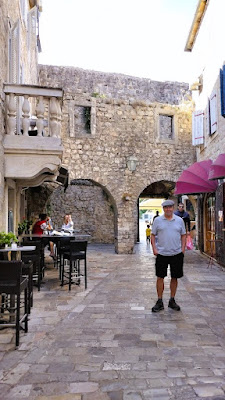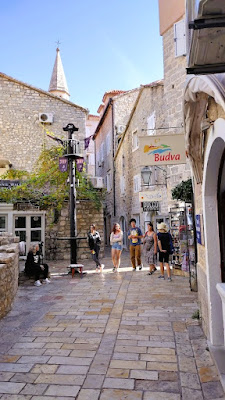Montenegro's most photographed site is Sveti Stefan, a small island near Budva that's connected to the mainland by a short causeway.
Originally built by the powerful Venetian Republic in the 12th Century as a fortress against Turkish pirates, over the centuries it became a residential neighborhood.
In the 1950s, the government of communist Yugoslavia nationalized the island, forcing residents to evacuate their homes in order to convert Sveti Stefan into an exclusive resort frequented by the celebrity jet-set of the era.
Yugoslavia knew how to cater to elites, who would seemingly be antithetical to Marxist ideals, confirming the impression I had as a child that Montenegro was a luxurious resort area inside the Iron Curtain.
It also confirms the blatant hypocrisy of leftists and elite statists who live in splendor while advocating sacrifice in a gray world for the constituents they purport to serve.
Over the decades, Sveti Stefan's poshness declined, so in 2007, the government of Montenegro negotiated a contract with Aman Resorts to revitalize the island under a thirty year lease.
Only paid guests are welcome on the luxurious resort island, so its inclusion as a destination of our excursion by Viator simply meant a photo op from shore.
When we arrived in nearby Budva, Julie and I were ready for lunch, so we sought out a seaside restaurant, which would again be brought under the usual scrutiny for a suitable combination of flavor, value and nutrition, plus in this case the additional parameters of scenic view and a certain je ne sais quoi.
We found the perfect place for us. Fisherman's Pub is the kind of eatery where fried fish or shrimp would suit my natural inclinations.
Having been eating lots of seafood on the cruise already, however, I was ready for Jimmy Buffett's recipe when in port, a cheeseburger in paradise with an ice cold beer.
Our table had a gorgeous view of boats along the shore.
With 20,000 residents, Budva is a considerably larger and more modern community than Perast, though definitely not a big city.
After finishing our delicious lunch, we meandered over to a small beach with pebbles instead of sand.
We didn't bring bathing suits ashore, much less masks and snorkels, so after taking some time to appreciate the beauty, we headed into the charming old town.
Budva is one of the oldest cities along the coast of the Adriatic Sea, founded by the Greeks 2500 years ago. Romans claimed Budva in the 2nd century BC. Following the fall of the Western Roman Empire, the Byzantines took control in the 6th century AD.
By the Middle Ages, Venetians ruled this valuable seaport until their republic fell in 1797, supplanted by the Austria-Hungary Habsburgs, who other than a few years during the French Revolution and World War I controlled Budva until 1918. Serbians then entered the city and claimed it for the Kingdom of Yugoslavia, which after World War II became the Socialist Federal Republic of Yugoslavia.
Old Budva is surrounded by impressive fortress walls built by Venetians in the 1400s. For centuries, these ancient walls encompassed the entire city of Budva.
None of this entered our minds as we walked around the old village window shopping. We rarely buy souvenirs, but upon seeing a "Friends" logo t-shirt with art portraits like Van Gogh, Dali and the Girl With the Pearl Earring instead of Ross, Rachel, Joey, et al, we impulsively had a t-shirt made for our granddaughter Emma, who had recently bought a sweatshirt with just the logo on it on a shopping trip with us. We're happy to say that she wears the t-shirt frequently.
As with the other villages we visited in Montenegro, we could have stayed for hours or days, but we eventually we wandered over to meet our driver at the designated time and place, driving back to Kotor for one last stroll before returning to the ship for our usual pre-dinner routine of coffee and then sail away cocktails.
Aperol Spritzes are just as refreshing in Montenegro as in Livorno. Then again, between the Roman and Venetian rules, echoes of Italy remain throughout the Adriatic region.
The Bay of Kotor fjords make for one of the most beautiful sunset sail aways anywhere. It made me think of my client Ron Y, who always preferred his balcony cruise rooms perched along the stern, overlooking the ship's wake just for such moments.
Interestingly, Ron saw my post about Kotor on facebook and said he was now living in Montenegro. He loves his new home, where he is refurbishing an "old stone palace." It sounds like a very cool alternative lifestyle.
Ron asked if I wanted to meet for a cup of coffee, but by then I had been back in Big Sky for months, having only recently found time to finish my blog posts about what turned out to be a truly magnificent Mediterranean cruise. I don't think I have been too subtle in my praise to say that Julie and I give Montenegro, which was our only new port on this cruise, two thumbs up.
 |
| My expressions get goofier as the beer level goes down. |


































.jpg)












































No comments:
Post a Comment